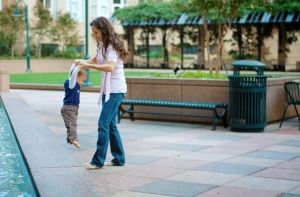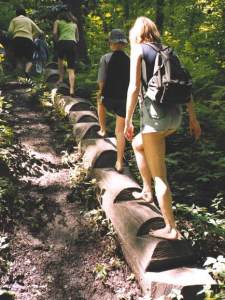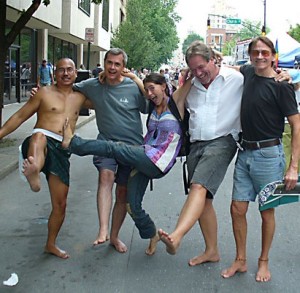Going barefoot can offer many immediate and long term benefits.
 Want to give it a try? With some simple practice, you can do it.
Want to give it a try? With some simple practice, you can do it.
Start slow. Listen to your body. Then, step by step, try to explore and expand your limits.
Feet used to wearing shoes may need some practice going barefoot. At first, you may experience some soreness or even blisters, but such problems will diminish with continued practice.
Start by going barefoot indoors. Then, expand your horizons to the outdoors, maybe in the backyard or at a park. Regular barefoot walking will toughen your feet, strengthen related muscles, and even help with posture and gait.
 Outdoors: Choose places with gentle and forgiving surfaces–grass, dirt and sand usually work well. Hiking paths can also offer a great venue for strengthening and toughening still tender feet.
Outdoors: Choose places with gentle and forgiving surfaces–grass, dirt and sand usually work well. Hiking paths can also offer a great venue for strengthening and toughening still tender feet.
Safety: Make sure you can see where you plant your foot. Avoid shuffling your feet in the grass or in dirt or leaf piles. Hidden dangers can exist. Watch where you step and step straight down. With extended walking, if you begin to feel pain or discomfort, stop and give your feet a rest. It takes time to strengthen and toughen them.
 Out and about in public – If you haven’t tried it, going barefoot in public may feel intimidating–but it can also feel quite liberating. Rest assured, others do go barefoot in public places–and they do it successfully. Examples here.
Out and about in public – If you haven’t tried it, going barefoot in public may feel intimidating–but it can also feel quite liberating. Rest assured, others do go barefoot in public places–and they do it successfully. Examples here.
What about hazards? One may sometimes encounter litter, glass or other potential dangers–but probably not as often as many may expect. And, with continued practice, feet become toughened and amazingly resilient to handle most potential hazards.
But don’t we generally ‘need’ shoes? When dealing with extreme weather conditions or certain work related circumstances, sure, we may need some type of foot protection. At such times we can regard shoes as useful tools–just as we might view a baseball glove as useful and needed to play baseball. That glove protects the hand during play–but most players don’t keep wearing the glove once off the field! So, we might ask ourselves: do we want to wear those shoes to meet a genuine ‘need,’ or simply to conform to social pressure or comply with current fashion trends?
How about barefoot hiking? Glad you asked. Here’s a Beginner’s Guide.
So go ahead . . . give it a try! But a word of caution!–once you get accustomed to going barefoot, you may find it difficult to go back to shoes.
